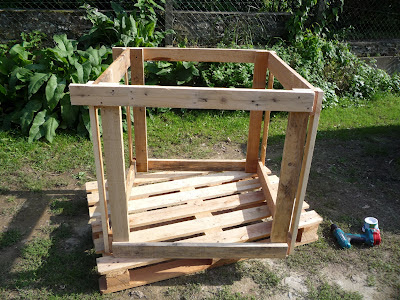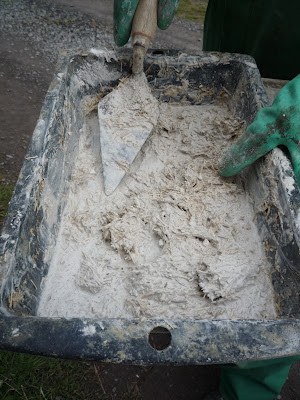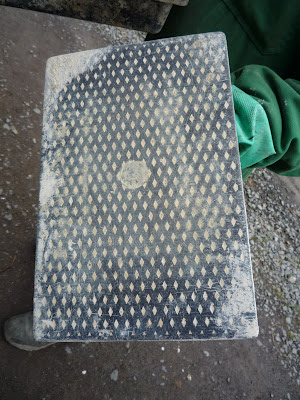Good for you, good for the planet and good for generations to come. There is an increasing body of evidence, if you needed it over the dictates of common-sense, linking toxic materials used in homes and working environments with disease and allergy.
Tiny House - Upgrading from Garden Retreat to Home from Home.
Preamble: Why bother using ecological materials?
You may be eating organic food, exercising, managing your weight and stress levels but you can still, in effect, be being poisoned in your own home. It's a strange sensation and one that is perhaps difficult to quantify but when you walk into a house that has been built or renovated with ecological materials you have an instant feeling of being in a healthy environment. In sourcing building materials we have always gone by a simple rule of thumb, firstly, we always read the packaging, research the ingredients and furthermore if the product sports a hazard warning, we don't usually want either to work with it or use it in our own home.
One of the problems or rather for us the joys of working with ecological materials is that they 'respond' to changes in climate so on a warm, dry day you may have to work faster or mix less. By its very nature an organic plant material will not have uniform properties, so in each batch you mix you may need to factor in more or less water or leave the mix longer before use. These are the reasons why working with ecological materials is so much more interesting and challenging but for some this would seem like, well, bother. This is potentially one of the reasons why until recently there were so few professional builders willing to use ecological materials. One of the most recent and innovative steps has been the invention of the hemp motar mix 'spray machine' for the use of ecological building materials in commercial buildings and on industrial estates. Years down the line when the building is finally dismantled it is composted. How about that as an alternative to kilometres of twisted metal, mountains of glass wool and tons of concrete all ending up in landfill!
Consulting the 'genius of the place'
After buying our home, which was a typical Celtic Longère/Longhouse, Sue was lucky enough to find an excellent book on vernacular architecture, which explored the function of every feature in the house. What we tried to do was to keep as many of these as possible from the 'built in' wall cupboards to the remaining original thatch-supporting roof carpentry. The materials we chose to renovate would have been the same ones originally used, those readily available, repurposed oak beams, lime, sand, clay and organic matter such as straw, linen and hemp. The roof insulation was the one place where we compromised, as at the time we could not get any ecological materials at all and opted for the least harmful polystyrene. Now thankfully there is a choice of roof insulation and as we have used the wonderful hemp fibre panels in reupholstery we would go on to use them in the roof.
Profiting from the lessons already learnt from working on the Main House
After re-roofing, the logical progression was to think about what to do with the interior. We had already started to work with lime mortars in pointing the main house walls and wanted to go on to use an ecological material to cover the walls. Many people who renovate vernacular houses leave the stone walls uncovered but there are several reasons we did not wish to do this. The most important one being that historically the walls were never meant to be of bare stone. The quality of stones used is neither aesthetically pleasing nor by its very nature, thermally efficient without an insulating covering. Our first idea was to look at what we had available with which to cover the walls, which was a whole loft full of straw. In the main house, in what was to be the Kitchen we covered the walls with a 5cm layer of lime mixed with the straw which we chopped by modifying a redundant electric lawn-mower and collecting the 'cuttings' in an attached black plastic dustbin bag! The first year we only had time to cover the North wall of the kitchen before the onset of Winter but we really noticed the difference in heat retention.

The first job was to remove the old plaster and lime wash. Old farm buildings traditionally were painted with a new coat every year. At one point the people who owned this property had actually painted around all the furniture so the walls were decorated with the surreal ghostly outlines of an armoire, grandfather clock and a box bed!
In the 18th Century this farmhouse would not have warranted glazed windows. Architecture tells us a social history of the period, one window per room on the South side, positioned so as to give maximum light to the fireplace to aid cooking. The doorways were wide because every night the farm animals were walked through the farmer's living quarters to get to theirs. Longhouses comprise alternate human/animal housing and the heat of the animals and the straw above meant warmth and insulation. We decided to open up a window in the North wall for a view of the garden and better natural light. We also replaced the lintels over the back doors, where needed. We mostly used oak but here, where a suitable oak beam could not be fitted in the available space, resorted to making our own from reinforced concrete.

The stone over the fireplace was attractive so we left it visible. Over the lime/straw we added a layer of lime and chopped hemp. We covered a small, unobtrusive patch and then leaving it to dry, ascertained that the golden colour of the straw was drawn through into the lime giving the Kitchen a very pleasing warm glow. We insulated the floor with the linen/lime mix.
In the Sitting room, lately home to a couple of sheep, we used linen and lime on the walls. We found it easier to work with than hemp. The colour was not pleasing, all the straw had gone so the linen went on to bare stone and came out a dismal grey on testing. Sue added a dark red earth pigment to each mix, which was just enough to lift the colour.
We also had an interesting problem with the flooring in that the house not only slopes from East to West but also from North to South. If we had tried to make the floor level it would have come up to the sill on the front window!

We solved the problem by making a split level floor, which was actually quite logical as it enhanced the enfilade through from the kitchen to the back door and out into the garden.
Sourcing green materials without going into the red.
There were two major problems when we started out to source ecological materials, twelve years ago they were very difficult to find and then when we could obtain them they were prohibitively expensive. Undaunted we decided to improvise and we could do this because we were renovating a farm building not a chateau. Firstly we used up all the straw we had available and then we started to work with hemp. The hemp which was sold in bags in various grades through specialist shops was very expensive but the same material sold as mulch and was certified organic for use in horticulture was a fraction of the price. Normally hemp for wall covering is applied to walls firstly as a coarse layer, then sometimes there is a medium grade layer and then lastly a fine finishing coat. Our grade of hemp was equivalent to the coarse layer but because of the nature of our house it was eminently suitable. We bought it directly from an agricultural supplier through the help of a friend who is an organic market gardener and had used it both as a mulch and as a building material in his newbuild eco home.

Later he suggested we tried linen as he had found this easier to work with. Both Sue and I had found hemp very tiring because making it bond with the wall needed quite an initial force to make it adhere before it cures. The linen absorbed water better than the hemp and was much easier to work. We sourced our chopped linen from that sold in bales for horse boxes
Some thoughts on lime
Lime is one of the rare materials we use which does carry a hazard warning. It does however come in two different forms and we always choose to use the more benign one. Aerated lime, or quick lime is a very tricky substance to use. Traditionally it is the one used in mortars because it has a much longer drying time than hydrated lime, thus it can be kept in a useable state, covered with wet sacking for a period of several days. This is particularly useful if you are working on a large expanse of wall, where you are looking for uniformity in finish. Personally we would rather have a few uneven sections in the wall and work with something much less dangerous. Actually unless you are working on a very hot and windy day you can easily finish a whole wall and match up sections before any of it dries out. Unless you are working on a church wall that is going to be used for frescos, I'd steer clear of it. I taught on a day course at an Eco Centre a couple of years ago, where they used aerated lime, We provided all the protective clothing and I gave an introductory talk on the materials and still someone managed to get some lime in their eye. Luckily we had made provision for bottles of water to be available everywhere on site so a quick eyebath was at hand.
When working on a wall to prepare it for receiving a coat of insulation, you should first point your wall with a lime and sand mortar. For pointing the ratio of lime to sand is as follows: six parts sand to one part lime. First rake out all loose and spalled mortar and then dampen down the wall. Pointing not only strengthens the wall bond but it also has two other functions one being financial, it enables the bonding of the insulation viz hemp/lime and also it cuts down the amount of this latter you have to use. Lime and sand are relatively cheap particularly if you buy them at a traditional builders' merchant, where you load them directly into your car and pay by weight.
Know your sands
There are different grades of sand and at a traditional builders' merchant you will find them labelled as such. If you are not sure what you should be using, just ask. For the finer jobs such as the lime mortars we used as a finish around the windows in the sitting room you will need a fine washed 'blond' sand but for stone work and pointing the cheaper unwashed sharp sands will suffice. Do not be tempted to collect your own sand from beaches or river beds, for one thing in most countries this is illegal and secondly it is one of the major causes of mundic or concrete cancer, in that impurities in the sand begin to oxidise in the dry mortar over time causing a weakening of the structure.
Up next 'Tackling the Tiny House'
In this garden the people are fenced in, otherwise you get a chicken on your dinner plate, literally!
Thanks for dropping by and please feel free to share this article, comment and/or ask questions.
Cheers,
Andy




















































